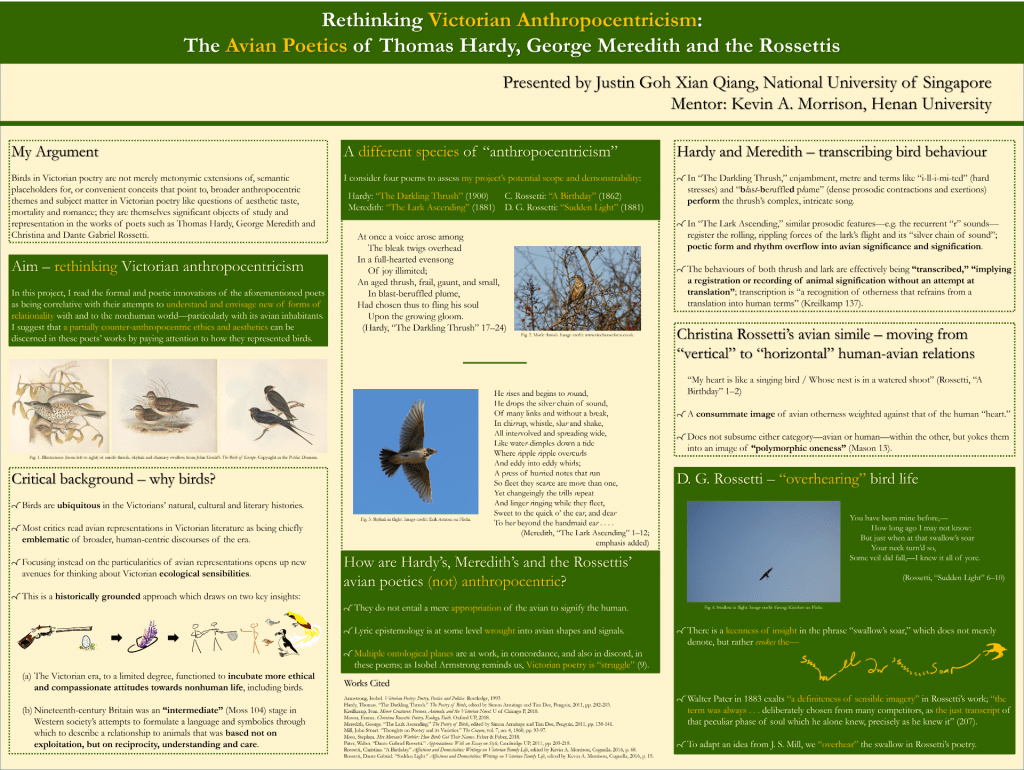
A mid-term overseas excursion involving almost sixty hours of travel can be no mere flight of fancy. From 17 to 19 October 2019, I was very privileged to be at the North American Victorian Studies Association’s (NAVSA) annual conference in Columbus, Ohio. I was there with the support of the English Language and Literature department at the National University of Singapore (NUS) and under the mentorship of Professor Kevin A. Morrison from Henan University, whom I met during a module on Victorian Literature and Culture that he had conducted as a Visiting Professor to NUS. Dr Morrison had nominated me to present a project at NAVSA 2019’s Undergraduate Research Event. Months of research following my acceptance into the programme, which found me stealing time from my vacation and coursework to read anything from Victorian lyric poetry to nineteenth-century animal welfare brochures, eventually yielded the theme of this project: “Rethinking Victorian Anthropocentricism: The Avian Poetics of Thomas Hardy, George Meredith and the Rossettis.”
Part of the research programme for undergraduates at NAVSA 2019 included a workshop. This was an opportunity for us to pitch our projects to one another, to refine our arguments against our peers’ evaluation. We also shared insights and experiences related to the challenges of preparing for the upcoming presentation. We spoke at length, for instance, about the difficulty of handling the specific genre we were assigned to work with: the academic poster. To compress reams of research into a mere five hundred words or so plus a handful of images was infinitely more demanding than a five thousand-word paper might have been. Yet the prevailing realisation was that such limitation could only be the impetus for radical creativity. Brevity boasts its own poetry. What was truly inspiring in the work of my peers was its sheer felicity and acumen: everybody was bold, open and in earnest about what they were sharing. I was deeply impressed, for example, by Hannah Calderazzo’s presentation titled “Unfeminine Legacies from Wilkie Collins’s The Woman in White to Victoria Cross’s Six Chapters of a Man’s Life,” which skilfully and imaginatively unpacked the transactions between nineteenth-century sensation fiction and classical tragedy. Hannah was extremely well-read and fluent in her knowledge of the period. Like every other participant at the conference, she was deeply in possession of her own niche, and proudly, unapologetically so.

In many ways it was the people who made the occasion. This was especially true during the undergraduate poster session, held on the third and final day of the conference. Our posters were arranged along corridors adjacent to seminar rooms in the Hilton Columbus Downtown where the conference was being hosted. Interested participants could approach individual presenters to talk about their projects. Here, I was quite overwhelmed by the encouraging feedback I received. Dr Maha Jafri from Sewanee, for example, summoned such tremendous energy to engage with my readings of Hardy, Meredith and the Rossettis; she also shared valuable information about where I might look up archives related to the work of Meredith (a writer whose work, we both agreed, suffers its own somewhat maligned, critically underappreciated dogmatic brilliance). I also got to test my interpretations of poems by Christina and Dante Gabriel Rossetti against the expertise of Professor Elizabeth K. Helsinger, whose work I had read when conducting my own research. Part of the difficulty of establishing an ecological reading of the Rossettis concerns how one might evaluate the theological preoccupations of their work. In simple terms, it’s difficult to say precisely that when, for instance, Christina Rossetti in “A Birthday” writes “My heart is like a singing bird / Whose nest is in a water’d shoot,” she is being as aware of the bird itself as she is with its symbolic properties. It was therefore immensely motivating to hear Professor Helsinger say, in agreement with my own intuitions, that, “Yes, I do think she sees the bird.” The poster session resonated, in sum, both effectively and affectively; it built my confidence and helped me sharpen my own critical perceptions.
I’ll finish this post with a thought that returns me home. Many of my fondest memories of NAVSA 2019, strangely enough, don’t come from Columbus at all. These include: the enthusiastic and unconditional support of my family; endless matrices of email correspondence with Dr Morrison on the details of the project, which he tirelessly and meticulously guided me through; Professor Lazar and Professor Sankaran’s warm encouragement before my trip; Dr Susan Ang’s illuminating discussions on Hopkins, Keats and Shelley; Ms Angeline Ang’s kindness and patience in guiding me through the administrative work of requesting conference funds; expedient emails from CLB containing articles requested via DDS that were essential in helping me define and refine my project; Dr Jennifer McDonell’s expert feedback on my ideas and poster design; Dr Michael Hollington’s hugely supportive response to my queries about his own work on Dickens and to my project; talks with Stasha Wong on environmentalism, animals and various things ecological; philosophical gymnastics with Tan Wei Lin on dialogism and Derrida; discussions with Joycelyn Lee Yuet Zhen on Dante Gabriel Rossetti’s “Sudden Light,” phonemes and the IPA chart. It’s this community of people back to whom I must trace the roots of the sweetness of my experience of NAVSA 2019, and so I do, with great wonder and gratitude.
Submitted by 3rd-year undergraduate Justin Goh.